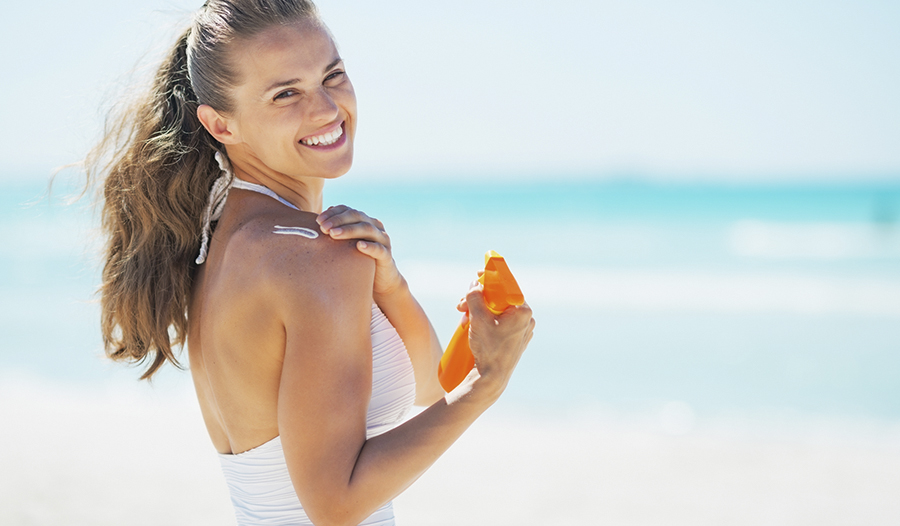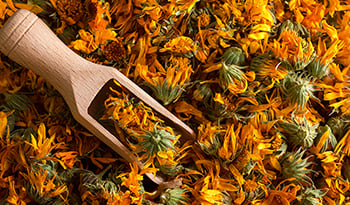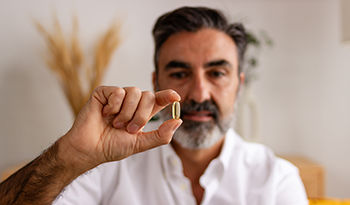Sfaturi de supraviețuire de vară pentru pielea ta

Aveți grijă de pielea dvs. în această vară cu aceste sfaturi.
Vara este plină de distracție la soare, dar poate face ravagii și pe pielea ta. Razele puternice ale soarelui care bate în jos vă pot lăsa pielea deteriorată și arsă. Din fericire, există lucruri pe care le puteți face pentru a vă menține protejat, în timp ce vă bucurați în continuare de tot ce are de oferit o zi însorită.
Protecție solară vs. Protecție solară
Cele mai frecvente măsuri de protecție sunt protecția solară și protecția solară. Chiar dacă sună similar, protecția solară și protecția solară sunt de fapt două lucruri diferite. Protecția solară se așează deasupra pielii pentru a crea o barieră care blochează razele UV dăunătoare. Protecția solară nu stă deasupra pielii ca o protecție solară și, în schimb, pătrunde în piele. Atât protecția solară, cât și protecția solară au aspectele lor pozitive și negative, care vor varia în funcție de nevoile dvs. Indiferent de ce folosești, asigură-te că ai un SPF adecvat pentru nevoile tale.
Ce este SPF?
Factorul de protecție solară, sau SPF, este o evaluare a cât timp protecția solară vă va proteja pielea de razele ultraviolete. Aceste raze provoacă arsuri solare și pot deteriora epiderma, care este locul în care se dezvoltă cele mai frecvente tipuri de cancer de piele. Numărul SPF indică cât de protejat sunteți de acele raze UV dăunătoare. De exemplu, atunci când o protecție solară este etichetată „SPF 30”, aceasta înseamnă că 1/30 din razele UV vor ajunge la piele. Pentru a funcționa corect, totuși, protecția solară trebuie aplicată conform instrucțiunilor de pe sticlă. Majoritatea experților recomandă utilizarea protecției solare sau a protecției solare cu un SPF de 30 sau mai mare pentru o protecție adecvată împotriva soarelui de vară. Puteți obține chiar și produse de protecție solară sau protecție solară de până la SPF 75.
Verificați data de expirare
Înainte de a aplica protecție solară sau protecție solară, asigurați-vă că verificați data de expirare. Dacă a trecut data de expirare sau a fost expus la temperaturi ridicate, este posibil să nu poată oferi protecția pentru care a fost proiectat odată. Dacă scoateți protecția solară de anul trecut din depozit pentru noul sezon de vară, există șanse mari să fie expirat. Nu riscați; aruncați acele sticle vechi în coșul de gunoi, optând pentru una nouă înainte de a ieși la soare.
Când și cum să aplicați corect
Când aplicați protecție solară sau protecție solară, citiți și urmați procesul de aplicare recomandat așa cum este indicat pe flacon. O regulă generală bună este să aplicați protecția solară sau protecția solară cu aproximativ 15 minute înainte de a ieși afară. Aplicați uniform loțiunea sau crema pe toate părțile expuse ale corpului, inclusiv urechile, precum și vârfurile picioarelor și picioarelor. De asemenea, ar trebui să aplicați un balsam de buze de protecție solară care are un SPF de cel puțin 15. Aplicați din nou protecția solară sau protecția solară cel puțin la fiecare două ore. De asemenea, trebuie reaplicat imediat după înot sau dacă ați transpirat excesiv. Dacă aveți vreodată îndoieli cu privire la necesitatea de a aplica din nou, puneți mai multă protecție solară pentru a fi în siguranță și pentru a evita arsurile solare.
Rețineți că, deși zilele însorite sunt cel mai frecvent moment pentru a vă arde, razele soarelui pot fi totuși dăunătoare chiar și într-o zi înnorată. Din această cauză, ar trebui să luați întotdeauna măsurile preventive necesare pentru a vă proteja pielea de fiecare dată când ieșiți afară. Acest lucru poate părea excesiv pentru unii, dar veți fi bucuroși că ați făcut acei pași suplimentari atunci când nu aveți de-a face cu efectele grave asociate razelor UV.
Acordați atenție ingredientelor
Chiar dacă protecția solară și protecția solară pot funcționa bine pentru a vă proteja pielea, nu ar trebui să luați doar o sticlă de pe raft și să nu vă gândiți la ingrediente sau la ce pot face pielii în timp ce le aplicați generos pe corp. Substanțele chimice inutile și adesea dăunătoare găsite în produsele de protecție solară și produsele de protecție solară pot fi absorbite în piele, provocând reacții pe termen lung și erupții alergice. Mai mult, cercetările efectuate de Grupul de lucru pentru mediu sugerează că unele substanțe chimice din produsele de protecție solară obișnuite și produsele de protecție solară sunt perturbatori endocrini, care pot interfera cu anumite procese hormonale, cum ar fi tiroida. Asta nu înseamnă că nu ar trebui să folosiți protecție solară sau protecție solară, dar ar trebui să acordați mai multă atenție ingredientelor înainte de a le aplica pe piele. Site-ul EWG poate oferi mai multe informații despre ingredientele de care trebuie să fiți atenți.
Purtați haine adecvate
Purtarea hainelor va proteja orice piele expusă de razele soarelui dăunătoare, dar nu toate hainele sunt create egale. Ar trebui să purtați pantaloni lungi și cămăși cu mâneci lungi, care sunt fabricate din țesătură strâns țesută pentru cea mai bună protecție împotriva razelor UV. În plus, îmbrăcămintea umedă este mai puțin protectoare decât îmbrăcămintea uscată, iar culorile întunecate pot oferi mai multă protecție decât cele care au o nuanță mai deschisă.
O pălărie este o altă modalitate excelentă de a vă proteja de soare fără a fi încuiat înăuntru. Pentru cele mai bune rezultate, purtați o pălărie care are o margine largă. Acest lucru vă va umbri nu numai capul, ci și fața, gâtul și urechile. În timp ce vă aflați la lucru, puneți o pereche de ochelari de soare care sunt proiectați să blocheze atât razele UVB, cât și razele UVA; cu cât procentul blocat este mai mare, cu atât mai bine.
Căutați zone umbrite și beți multă apă
În timp ce sunteți la soare, asigurați-vă că faceți în mod regulat pauze într-o zonă umbrită. Acest lucru este deosebit de important în timpul orelor de amiază, când soarele este cel mai strălucitor. Nu uitați să beți multă apă pentru a vă menține corpul hidratat. Ambii acești pași simpli vor contribui mult la prevenirea arsurilor solare și la menținerea sănătății.
Luați în considerare utilizarea tăbăcătoarelor fără soare
Bronzarea este o activitate populară desfășurată la soare care poate fi dăunătoare sănătății pielii tale. Înainte de a vă supune pielea razelor dure ale soarelui de vară, luați în considerare o opțiune bronzatoare fără soare . Utilizarea tăbăcătorilor fără soare vă oferă aceleași rezultate ca și cum ați fi stat la soare, dar fără efecte secundare dăunătoare. Bronzarea la soare îți crește șansa de a experimenta riduri și îmbătrânire prematură și te lasă cu linii bronzate uneori jenante. Nu veți experimenta acest lucru cu tăbăcătorii fără soare. Aceste produse sunt, de asemenea, utile pentru acoperirea petelor, ascunderea cicatricilor și a venelor de păianjen și tonurile pielii de seară.
Remedii pentru arsuri solare
Arsurile solare nu sunt deloc distractive și pot face chiar și cea mai simplă corvoadă zilnică dureroasă și neplăcută. Din fericire, există mai multe remedii naturale pentru ameliorarea arsurilor solare pe care le puteți face chiar în propria casă cu produse ieftine și ușor disponibile.
Amidon de porumb/ bicarbonat de sodiu
Dacă aveți amidon de porumb sau bicarbonat de sodiu în cămară, turnați puțin într-un bol de amestecare și amestecați puțină apă rece. Continuați să adăugați apa rece până se formează o pastă groasă. Întindeți ușor pasta de ameliorare a arsurilor de casă peste arsurile solare și lăsați-o să stea până când durerea sau căldura s-au diminuat. Odată ce se întâmplă acest lucru, clătiți ușor pasta cu apă rece.
Mentă și ceai verde
Un alt remediu pentru arsurile solare este utilizarea frunzelor proaspete de mentă și a ceaiului pentru a ameliora durerea, ajutând în același timp la vindecarea pielii deteriorate. Menta este cunoscută pentru capacitatea sa naturală de a calma și răci, în timp ce teobromina și acidul tanic din ceaiul verde acționează ca analgezice și vindecători ai pielii. Pentru a face acest remediu, așezați cinci pungi de ceai verde - asigurați-vă că îndepărtați etichetele și șirurile - și 3 căni de frunze de mentă într-un castron mare sau tigaie. Se toarnă 1 litru de apă clocotită peste ceai și mentă și se acoperă cu un capac. Lăsați amestecul să se aburească aproximativ o oră. Scoateți și aruncați pungile de ceai și menta înainte de a răci ceaiul în frigider. Când este gata de utilizare, saturați o cârpă moale cu ceaiul și aplicați-l direct pe arsurile solare, după cum este necesar.
Hazel de vrăjitoare
Hamamelis poate avea un nume înfricoșător, dar a fost folosit de secole pentru a trata o serie de afecțiuni diferite. Alunul de vrăjitoare conține în mod natural taninuri, care pot ajuta la reducerea umflăturii, la menținerea bacteriilor la distanță și la repararea pielii deteriorate de soare. Tot ce aveți nevoie pentru acest remediu pentru ameliorarea arsurilor solare este o cârpă umezită în hamamelis. Doar tamponați cârpa saturată peste zona afectată, după cum este necesar.
Oțet de cidru de mere
Oțetul este, de asemenea, un instrument util care ar trebui să facă parte din kitul de ameliorare a arsurilor solare. Nu numai că oțetul este un deodorizant natural, degresant și un produs de curățare, dar poate ajuta la vindecarea arsurilor solare. Cu toate acestea, nu puteți folosi doar oțet alb distilat obișnuit; va trebui în schimb să utilizați oțet de cidru de mere. Umpleți o sticlă de pulverizare cu aproximativ 1 cană de oțet de cidru de mere. Așteptați până când ați făcut un duș numai cu apă dacă vă simțiți în stare și pulverizați ușor zona arsă de soare cu oțet. Reaplicați după cum este necesar.
Produse de Aloe și Calendula
Dacă nu doriți să vă faceți propria ușurare a arsurilor solare, nu vă faceți griji. Există mai multe produse gata preparate disponibile la magazinul dvs. alimentar local sau farmacie. Aceste produse conțin în general aloe vera sau calendula. Aloe vera este o plantă populară care este adesea cunoscută sub numele de „planta arsă” pentru capacitatea sa de a calma și vindeca pielea arsă. Calendula este o floare portocalie aurie care conține în mod natural antioxidanți. A fost folosit de mulți ani pentru a calma și hrăni pielea afectată de soare.
În cele din urmă...
Luarea măsurilor preventive necesare împotriva razelor dăunătoare ale soarelui este cea mai bună apărare împotriva efectelor potențial dăunătoare pe care le pot avea asupra pielii tale. Nu ai prefera să-ți iei timp suplimentar pentru a ține la distanță arsurile solare decât să încerci să te descurci cu una când suferi deja prin ea? După cum spune vechea zicală, „O uncie de prevenire valorează un kilogram de leac”. Amintiți-vă asta înainte de a ieși pe ușă pentru a vă bucura de o zi afară.
Declarație de declinare a responsabilității:Acest blog nu are ca scop să ofere un diagnostic.













































































 Cuprins
Cuprins















